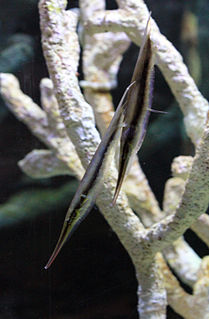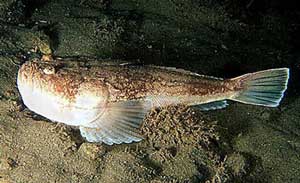
The Poeciliidae are a family of freshwater fishes of the order Cyprinodontiformes, the tooth-carps, and include well-known live-bearing aquarium fish, such as the guppy, molly, platy, and swordtail. The original distribution of the family was the Southeastern United States to north of Río de la Plata, Argentina, and Africa, including Madagascar. Due to release of aquarium specimens and the widespread use of species of the genera Poecilia and Gambusia for mosquito control, though, poeciliids can today be found in all tropical and subtropical areas of the world. In addition, Poecilia and Gambusia specimens have been identified in hot springs pools as far north as Banff, Alberta.

Gambusia is a large genus of viviparous fish in the family Poeciliidae. Gambusia contains over 40 species, most of which are principally found in freshwater habitats, though some species may also be found in brackish or saltwater habitats. The type species is the Cuban gambusia, G. punctata. The greatest species richness is in Mexico, Texas, and the Greater Antilles, but species are also found elsewhere in the eastern and southern United States, the Bahamas, Central America, and Colombia. Gambusia species are often called topminnows, or simply gambusias; they are also known as mosquitofish, which, however, refers more specifically to two species, G. affinis and G. holbrooki, which are often introduced into ponds to eat mosquito larvae. As a consequence, they have been introduced widely outside their native range, and frequently become invasive, threatening local species. They are only occasionally kept in aquariums, due to their relative lack of color and the highly aggressive nature of the aforementioned mosquitofish species.

The rainbowfish are a family, Melanotaeniidae, of small, colourful, freshwater fish found in northern and eastern Australia, New Guinea, islands in Cenderawasih Bay and Raja Ampat Islands in Indonesia, and in Madagascar.

Shrimpfish, also called razorfish, are five small species of marine fishes in the subfamily Centriscinae of the family Centriscidae. The species in the genera Aeoliscus and Centriscus are found in relatively shallow tropical parts of the Indo-Pacific, while the banded bellowsfish, which often is placed in the subfamily Macroramphosinae instead, is restricted to deeper southern oceans.

The Centriscidae are a family of fishes from the order Syngnathiformes which includes the snipefishes, shrimpfishes, and bellowfishes. A small family, consisting of only about a dozen marine species, they are of an unusual appearance, as reflected by their common names. The species in this family are restricted to relatively shallow, tropical parts of the Indo-Pacific.

The banded bellowsfish, banded yellowfish, banded snipefish, or bluebanded bellowsfish, is a species of fish of the family Macroramphosidae, found in southern oceans at depths of 35 to 1,000 m. Its length is up to 30 cm (12 in).

The crested bellowsfish or crested bellowfish, Notopogon lilliei, is a species of fish from the family Macroramphosidae, found is a demersal species of fish which occurs over the continental shelf at depths 0f 80 to 600 m. They grow to lengths of up to 27 cm (11 in).

Macroramphosus, snipefishes or bellowfishes, is a genus of fishes found in tropical and subtropical oceans at depths down to 600 metres (2,000 ft). According to FishBase, they are part of the family Centriscidae, but Nelson (2016) split that family, in which case the genus Macroramphosus is in the family Macroramphosidae. They have long second spines on their dorsal fins and tiny mouths at the tip of their greatly elongated snouts. The bodies of snipefish are more streamlined than in the related bellowfishes. They reach a maximum length of about 20 cm (7.9 in), and are silvery or reddish in colour. They are sometimes found in large schools. This is the only genus on the monogeneric family Macroranphosidae but some authorities include the genera Centriscops and Notopogon in this family too.

The longspine snipefish, bellowfish, common bellowsfish, snipe-fish, snipefish, spine trumpet fish, or trumpetfish, Macroramphosus scolopax, is a snipefish of the genus Macroramphosus. It is also known as the slender snipefish off the South African coast.

The orange bellowsfish is a species of fish of the family Macroramphosidae, found around South America, at depths of 150 to 580 m. Its length is up to 18 cm (7.1 in).

The trumpetfishes are three species of highly specialized, tubular-elongated marine fishes in the genus Aulostomus, of the monogeneric family Aulostomidae. The trumpetfishes are members of the order Syngnathiformes, together with the seahorses and the similarly built, closely related cornetfishes.

Macroramphosidae, the snipefishes and bellowsfishes is a family of oviparous, marine fish which form part of the superfamily Centriscoidea, which is one of the two superfamilies in the suborder Aulostomoidei of the order Syngnathiformes, which includes the seahorses, pipefishes, trumpetfishes and dragonets. It has been considered to be a subfamily of the Centriscidae but Nelson (2016) classified it as a family.

Champsodon is the sole genus in the family Champsodontidae. These fishes, the crocodile toothfishes, are native to the Indo-Pacific region.

Uranoscopus is a genus of stargazer fish from the family Uranoscopidae. The name Uranoscopus is from the Greek, ouranos, "sky" and skopein, "to watch".

Lophiodes is a genus of goosefishes. It is one of four extant genera in the family Lophiidae.
Centriscus is a genus of shrimpfishes found in the Indian and Pacific Oceans.

Lepidoperca is a small genus of fish belonging to the Anthiinae subfamily. It includes ten species.

Poeciliinae is a subfamily of killifish from the family Poeciliidae which contains species from the Americas which are collectively known as the livebearers because many, but not all, of the species within the subfamily are ovoviviparous.
The Longsnout Bellowfish is a species of fish from the family Macroramphosidae. It is found in the Southeast Atlantic Ocean, from southern Namibia to Saldanha Bay in South Africa. It lives at depths from 200 to 500 metres. It grows to a maximum length of 33 centimetres (13 in).

The longspine bellowfish is a species of fish of the family Centriscidae. It is found in the subtropical belt of the Southern hemisphere, from South Africa to the St. Paul and Amsterdam Islands to New Zealand. Its range extends North as far as Madagascar and New Caledonia. It is found at depths of 100m to 700m. It can grow to lengths of 18 cm.


















